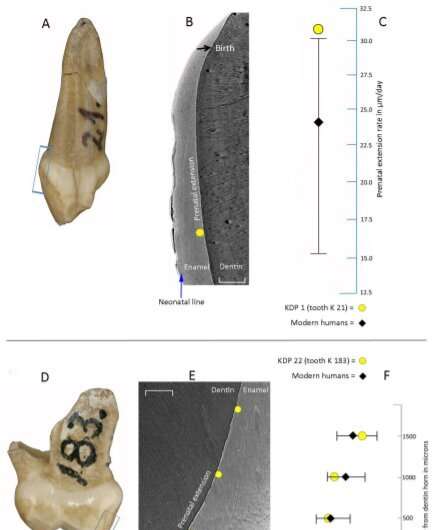Preserved baby Neanderthal milk tooth shows earlier emergence than in humans
An international team of researchers studying a recovered Neanderthal milk tooth has found evidence of baby teeth growing faster and emerging earlier in the extinct human species than in modern humans. In their paper published in Proceedings of the Royal Society B, the group describes their study.
In modern humans, deciduous teeth, also known as baby teeth, or milk teeth, generally emerge from the gums around seven to 10 months of age. They remain in place for approximately six years, when they are replaced by succedaneous or permanent dentition. Prior research has shown that the enamel that covers milk teeth has neonatal lines that mark the point where enamel was produced before and after a baby is born. Prior research has also shown that enamel grows on teeth in a daily cycle, which gives them cross-striations. The amount of tooth growth in a single day can be seen in the distance between the stripes. In this new effort, the researchers used this information as they studied a Neanderthal milk tooth from a child who lived approximately 120,000 near what is now the city of Krapina in Croatia.
In studying the milk tooth, the researchers were able to plot out how quickly the tooth had grown in the child and the time in its life when it emerged from the gum—sometime between four and seven months of age. This finding suggests teeth began emerging from gums in Neanderthal children several months earlier than they do in modern humans. Thus, Neanderthal children likely began eating solid food sooner than is the case with modern human children. The researchers confirmed their results by comparing what they had found with another Neanderthal preserved jawbone that had three intact teeth. The researchers suggest that Neanderthals may have needed to begin eating a more diverse array of foods earlier in life than modern humans, because they would have needed more energy to nourish their large brains. Prior research has suggested they were larger than the brains of modern humans.Closer look shows Neanderthals on La Cotte de St Brelade interbred with modern humans
More information: Patrick Mahoney et al, Growth of Neanderthal infants from Krapina (120–130 ka), Croatia, Proceedings of the Royal Society B: Biological Sciences (2021). DOI: 10.1098/rspb.2021.2079
Journal information: Proceedings of the Royal Society B
© 2021 Science X Network

No comments:
Post a Comment